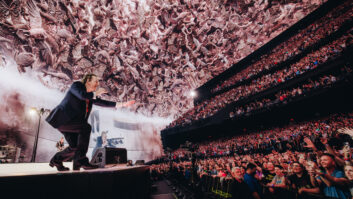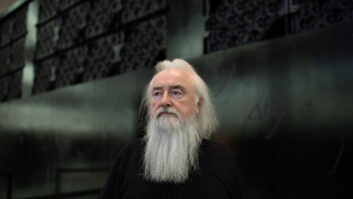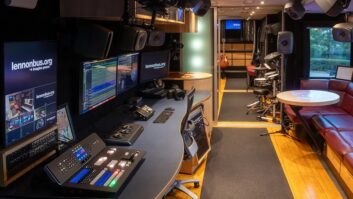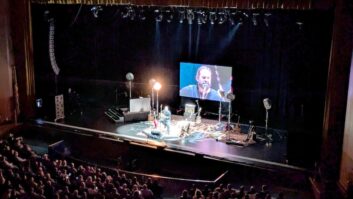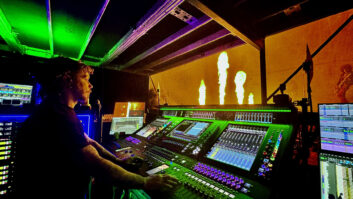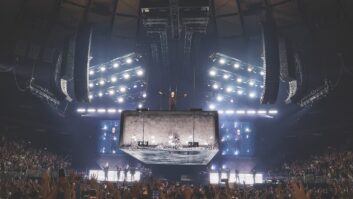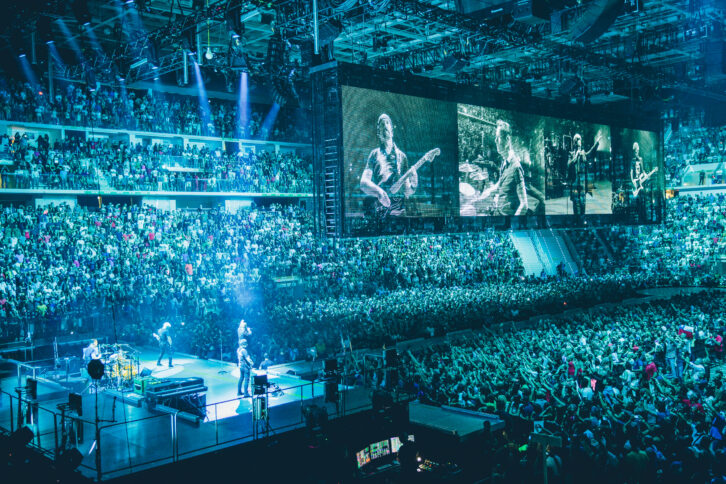
New York, NY (November 13, 2015—There were a lot of dramatic stories leading up to U2’s Innocence + Experience world tour, the current leg of which ends this month in Dublin, Ireland. Most of them are easily Googled, but here’s one you might not have heard. Last December, the group played New York City’s Times Square for World AIDS Day, with Bruce Springsteen and others sitting in for lead singer Bono, who was recovering from a bicycle accident. The band’s audio supplier, Clair Global, was involved, so Joe O’Herlihy, U2’s sound director since the 1970s, found himself in the company’s hometown of Lititz, PA. during the days leading up to the event.
“We were prepping,” he recalled months later, staring out across the expanse of Madison Square Garden on the last night of the band’s North American leg. “I just happened to be in the right place at the wrong time, as they say, because the engineering department were testing a column of Cohesion CO-12s. I’d been part and parcel of their development for two years, but hadn’t heard this; I said, ‘Oh, that sounds amazing.’ The sonic quality, the intelligibility was just something else—but they weren’t going to happen until September, 2015.”
Fast-forward three months to February 8; the U2 team was back in Lititz when it discovered that the production, as it was designed on paper, would require 225,000 lbs. of lights, rigging, video and sound to be hung from arena ceilings—far past the average arena ceiling’s weight limit. The production had to go on a diet and hit a max of 180,000 lbs. “My original design was based around Clair’s I5 boxes, and the configuration was 78,600 lbs.,” said O’Herlihy. Doing some quick math, it was determined the same arrangement built with CO-12 boxes would weigh 44,200 lbs., including cabling and trussing. The only catch was that the U2 tour was starting in exactly two months on April 8, and CO-12s wouldn’t go into production until the fall.
Needless to say, opening night in Vancouver found U2 playing beneath 120 CO-12 boxes. “The paint was barely dry!” laughed Greg Hall, Clair Global’s business manager, still somewhat incredulous that they made it happen. O’Herlihy agreed but added, “Delivering that has been a major coup—for me putting U2 into the frame to be the first band to use it, and Clair for their commitment to run with it and turn September into April.”
The push into new territory, however, matches the rest of the production, which makes the most of an arena’s floor, centering on a main stage at one end with a thin runway cutting lengthwise down the venue to the other end’s circular B-stage, dubbed “the E stage,” as in “Experience.” Above the runway hangs a massive, double-sided screen—“The Divider”—presenting video to both halves of the venue.
Since the band and screen command so much visual real estate—and use all of it continuously throughout the show—O’Herlihy’s Lab.gruppen-powered PA design adapts the traditional in-the-round format, broadening it into an oval that follows the curvature of the arena floor’s rim. Creating a nearfield speaker-like sound field, a stereo image is created across a dozen flown arrays, consisting of up to 12 Cohesion CO-12 boxes, each hang equidistant from the next, all complemented by eight hangs of three Cohesion CP-218 subs, using the cardioid method to steer bass energy into the venue. Meanwhile, 56 Cohesion CO-8 speakers—which Clair has had for some time—are used for downfills and centerfills above the various stages, and also for front fills down at ground level. With so many hangs so close to the audience, the result is a PA that doesn’t have to be driven hard to hit the show’s average of 100 dB, peaking around 104.
Another benefit of the system arrangement? Since every inch of a venue gets the same stereo image, the FOH position doesn’t have to be confined to the arena floor. As a result, O’Herlihy can usually be found mixing up in the stands. For the band’s eight-show run at Madison Square Garden, he was on the top deck above the luxury boxes at midcourt. “I really fought hard to get that location actually,” he recalled. The vantage point was ideal, providing clear sightlines of the entire sprawling production.
It was also a good place to be because there was room for the considerable FOH mix position, complete with racks of outboard gear, and two DiGiCo SD7 consoles (one sitting there as a redundant backup). O’Herlihy’s desks have snapshots saved for 70-80 songs: “It’s fantastic to have the snapshot available that you can access each and every one of those songs in the event of Bono coming around and saying, as he has done in several occasions on this tour, ‘Okay, we’re going to play ‘Stuck in a Moment’ instead of whatever song that’s listed.’”
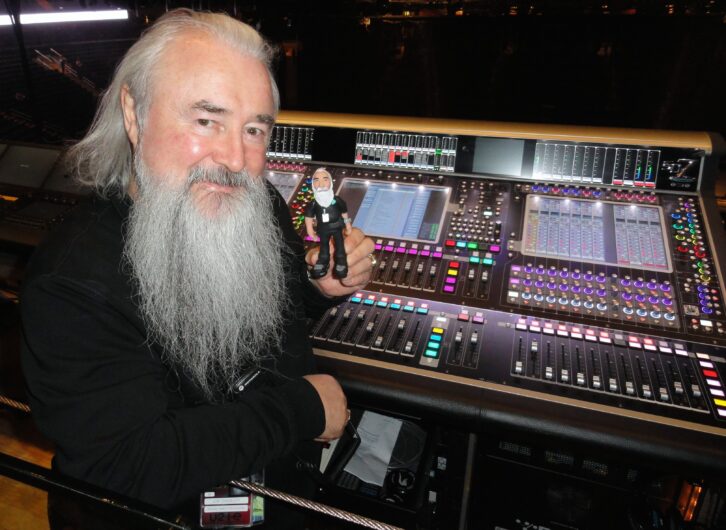
Given the prevalence of plug-ins these days that can replicate nearly any piece of outboard gear imaginable, why would O’Herlihy bring multiple racks of vintage gear out on the road? The short answer is: Because he can.
Acknowledging the appeal, accessibility and non-existent weight of plug-ins, O’Herlihy nonetheless explained, “All of them portrayed and are presented as to replicate what’s in my rack, which is the real, vintage product, like the Manley VoxBox; I use a couple of those for Bono’s vocals. There’s an Avalon 747 there for Edge’s vocals. The Summit DCL-200s? I absolutely love them and I’ve got eight on all of Edge’s amps—and they’re the real deal. These vintage devices sound as sweet and as right as they should. There’s absolutely nothing wrong with DiGiCo’s onboard effects and I use quite a bit of the SD7’s dynamics in specific channels, but there’s a few things I have for particular treatments and effects—like this ancient Yamaha SPX1000. They were used in the studio for certain sound effects, like the vocal on ‘The Fly,’ and you can only get it in that device. It’s weird, but if that’s what we need to do, then we do that.”
Beneath the main stage sits monitorworld—a warren of three mix positions, each with its own DiGiCo SD7 (plus a floating, redundant spare), overseen by Alastair McMillan, mixing for Bono; Richard Rainey, mixing for The Edge; and CJ Eriksson, mixing for Adam Clayton and Larry Mullin Jr. Also in the under-stage area is senior monitor systems engineer, Niall Slevin, who handles all the production’s RF. Given the massive video setup and variety of venues that the tour will visit through its worldwide travels, prepping its RF was no simple matter, requiring two days of testing The Divider at video hardware provider PRG Nocturne in Birmingham, UK—where O’Herlihy’s son Mark works. “We went up into the frame [between the two back-to-back screens] and tested every possible frequency for every possible territory,” said O’Herlihy. “It was the best piece of R&D that we’ve ever done because ultimately, touch wood, we haven’t had any RF difficulty so far.”
There’s still a long way to go—it was broadly hinted that the production has extensive, if so far unveiled, plans for next year. Meanwhile, the band keeps streamlining its show, night after night, changing set lists, arrangements, video material and more. “During the rehearsal process, we were into 60-70 songs in the entire catalog and then about 10 of the new songs, so it’s a good mixture between the old and new,” noted O’Herlihy. The same could be said for the tour’s audio system.
Clair Global
Clairglobal.com
DiGiCo
Digico.biz
This story originally appeared in Pro Sound News, November 2015, as U2—Old and New with Innocence + Experience.
